The AMD Ryzen 5 1600X vs Core i5 Review: Twelve Threads vs Four at $250
by Ian Cutress on April 11, 2017 9:00 AM ESTBenchmarking Performance: CPU Office Tests
The office programs we use for benchmarking aren't specific programs per-se, but industry standard tests that hold weight with professionals. The goal of these tests is to use an array of software and techniques that a typical office user might encounter, such as video conferencing, document editing, architectural modelling, and so on and so forth. At present we have two such tools to use.
PCMark8
Despite originally coming out in 2008/2009, Futuremark has maintained PCMark8 to remain relevant in 2017. On the scale of complicated tasks, PCMark focuses more on the low-to-mid range of professional workloads, making it a good indicator for what people consider 'office' work. We run the benchmark from the commandline in 'conventional' mode, meaning C++ over OpenCL, to remove the graphics card from the equation and focus purely on the CPU. PCMark8 offers Home, Work and Creative workloads, with some software tests shared and others unique to each benchmark set.
Chromium Compile (v56)
Our new compilation test uses Windows 10 Pro, VS Community 2015.3 with the Win10 SDK to combile a nightly build of Chromium. We've fixed the test for a build in late March 2017, and we run a fresh full compile in our test. Compilation is the typical example given of a variable threaded workload - some of the compile and linking is linear, whereas other parts are multithreaded.
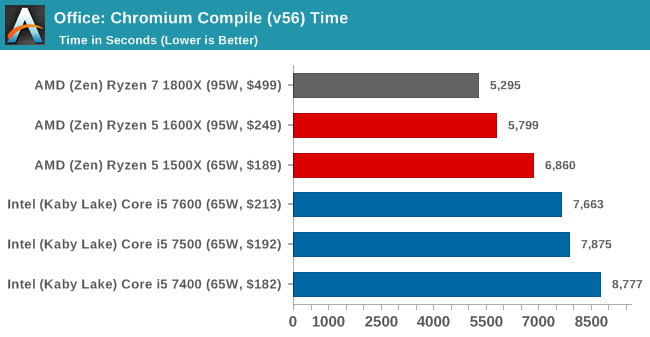
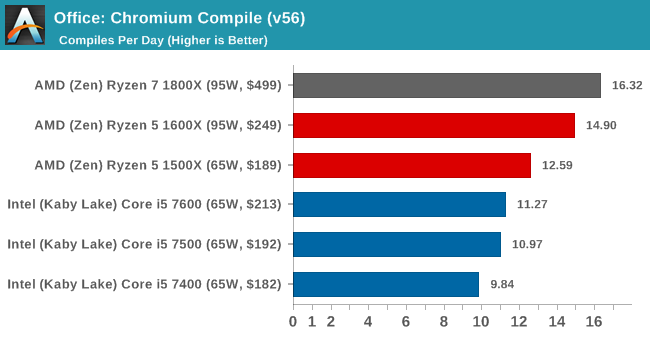
SYSmark 2014 SE
SYSmark is developed by Bapco, a consortium of industry CPU companies. The goal of SYSmark is to take stripped down versions of popular software, such as Photoshop and Onenote, and measure how long it takes to process certain tasks within that software. The end result is a score for each of the three segments (Office, Media, Data) as well as an overall score. Here a reference system (Core i3-6100, 4GB DDR3, 256GB SSD, Integrated HD 530 graphics) is used to provide a baseline score of 1000 in each test.
A note on contect for these numbers. AMD left Bapco in the last two years, due to differences of opinion on how the benchmarking suites were chosen and AMD believed the tests are angled towards Intel processors and had optimizations to show bigger differences than what AMD felt was present. The following benchmarks are provided as data, but the conflict of opinion between the two companies on the validity of the benchmark is provided as context for the following numbers.







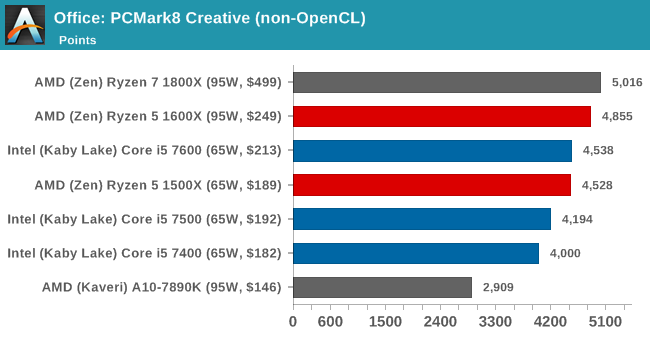
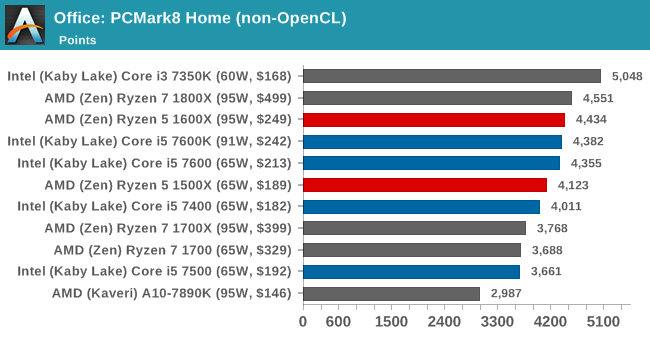
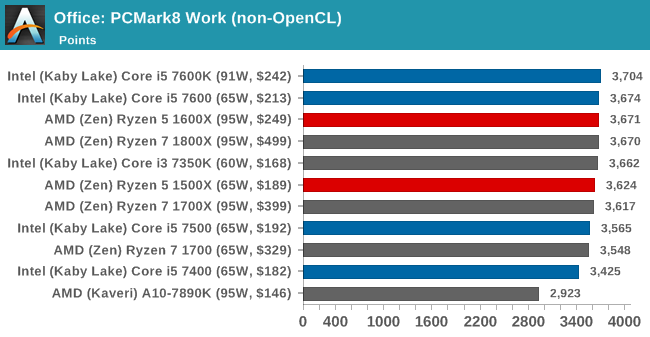








254 Comments
View All Comments
vladx - Thursday, April 13, 2017 - link
Yes as someone with both a 7700k system and a 1700X system I can safely call myself unbiased as I hold no special loyalty towards any brand.Cooe - Monday, March 1, 2021 - link
Liar liar, pants on fire lol.cryosx - Thursday, April 13, 2017 - link
they were testing against the direct competition (i5s) and the rest of the ryzen family. Makes sense, though I guess having the i7s in would be a nice touch.Nightsd01 - Wednesday, April 12, 2017 - link
"[Ryzen] has 50% more cores and 200% more threads"Wouldn't it be 300% more threads? 12 threads is 3x more than 4
Outlander_04 - Thursday, April 13, 2017 - link
200% MOREcvearl - Thursday, April 13, 2017 - link
Curious what method on GTAV was used. I get in the 70's at those settings on my RX480 all VH settings on an i7 2600k.ianmills - Thursday, April 13, 2017 - link
Dolphin benchmarks still missing!Notmyusualid - Tuesday, April 18, 2017 - link
@ianmillsI was looking for them too.
msroadkill612 - Thursday, April 13, 2017 - link
Ryzens tough for cheapskates. its a nice cheap 4 core, but gee, for so little more u get a 6 core 1600.msroadkill612 - Thursday, April 13, 2017 - link
zen is just amds first act.The second is naples - gluing multiple ryzens together using their excellent new plumbing.
The third is vega (gpu has long been amdS focus - in a10apuS e.g.).
The last and seismic act, is a ccx with a single zen core block of four cores & same 4mb l3 cache, and a vega gpu, possibly with hbm2 vram.
Its not very new ground for them. its very similar to the architecture solutions needed for the a10.
Incidentally, i heard a great debate about "dark coding?".
coders love using the gpu for compute when they can, cos it shifts heat away from stressed processors. cooler processors can then run faster. IE, they try and shift the load around the circuitry to avoid generating hot spots.
The conclusion omitted to say "if u consider pc software static.... Then buy intel"
new generation and paradigm, or the last tart up of the old generation. Your choice.
There are of course wins and losses by both, but we know that we are measuring the best of the old, with the lowest point of the rapidly improving new. (see ashes of singularitytweak)
& as above, its just act 1 now.
The authors haughty dismissal of amdS top am4 chipset features is outrageously deceptive (as said in posts here).